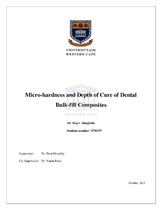| dc.description.abstract | Resin composite is one of the most commonly used materials in restorative dentistry. However, it has undergone continuous developments like changes in the fillers and initiators. One such improvement is the new bulk-fill composites which are materials intended for bulk placement up to 4mm. However, an optimum polymerization to the full depth of the restoration i.e. complete depth of cure is of utmost importance in order to obtain proper mechanical and physical properties of resin composites. Aim: The aim of this study was to measure the surface hardness of the top and bottom surfaces of the composites and to determine the depth of cure of bulk-fill composites using two different types of light curing units. Material and methods: A total of 160 specimens were used in this study: four bulk-fill composite were used of which two were conventional viscosity bulk-fill composites namely, Tetric N Ceram (Ivoclar Vivadent) and SureFil bulk-fill composite (Densply Caulk) and two were low viscosity flowable bulk-fill composites namely, SDR flowable (Densply Caulk) and Filtek bulk-fill flowable restorative (3M ESPE). Two different curing light were used namely, LED (Elipar Freelight, 3M ESPE) at 1500mW/cm2 and a Quartz Tungsten Halogen (QTH) curing unit (Megalux CS, Megadenta, Germany) at 600 mW/cm2. To evaluate micro-hardness, Vickers hardness at top and bottom of each sample was measured immediately after light curing and after 24 hours post curing using a Zwick micro-hardness machine load 300g/15 seconds. The mean hardness values obtained from the top and the bottom surface of each material were used to compare the micro-hardness of the various materials. The mean values obtained from the bottom surface were compared to the respective values of the top surface of each material (bottom/top ratio) and used to calculate the depth of cure. Results: The micro-hardness test showed a significant difference between the four materials (ANOVA, p<0.05) immediately after curing and after 24 hours post curing. The material with the greatest micro-hardness was SureFil followed by Tetric N Ceram, Filtek bulk-fill flowable and SDR flowable respectively. The material with the greatest depth of cure was Filtek bulk-fill flowable followed by SDR flowable, Tetric N Ceram and SureFil. When the curing lights were compared the Light Emitting Diode Curing Unit (LED) obtained significantly better depth of cure compared to Quartz Tungsten Halogen Light Curing Units. The LED curing light showed greater micro-hardness values than the QTH curing light except for Tetric N Ceram where the QTH curing showed more hardness values than the LED curing light. For all materials, the surface hardness and depth of cure values increased when tested 24hrs after light curing. Conclusion: There was a difference in the micro-hardness values between the four materials where the conventional viscosity materials showed greater surface hardness values than the low viscosity materials but the depth of cure compared to the bulk-fill flowable LED curing lights showed higher hardness values than QTH curing light except for Tetric N Ceram. Depth of cure ratios were found to be lower than 0.80 for all composite types, however the flowable bulk-fill materials showed higher depth of cure than the conventional viscosity bulk-fills. In general LED curing light produced better hardness and depth of cure values than QTH curing light. The low micro-hardness values for the bulk-fill flowable composites and the inadequate polymerization raises a concern regarding placing these materials in bulk. In such cases, the flowable bulk-fills should be protected with a conventional composite "covering or capping" especially in posterior teeth and in deeper cavities. Furthermore, bulk-fill composites should be used in layering incremental technique to ensure sufficient depth of cure. | en_US |

